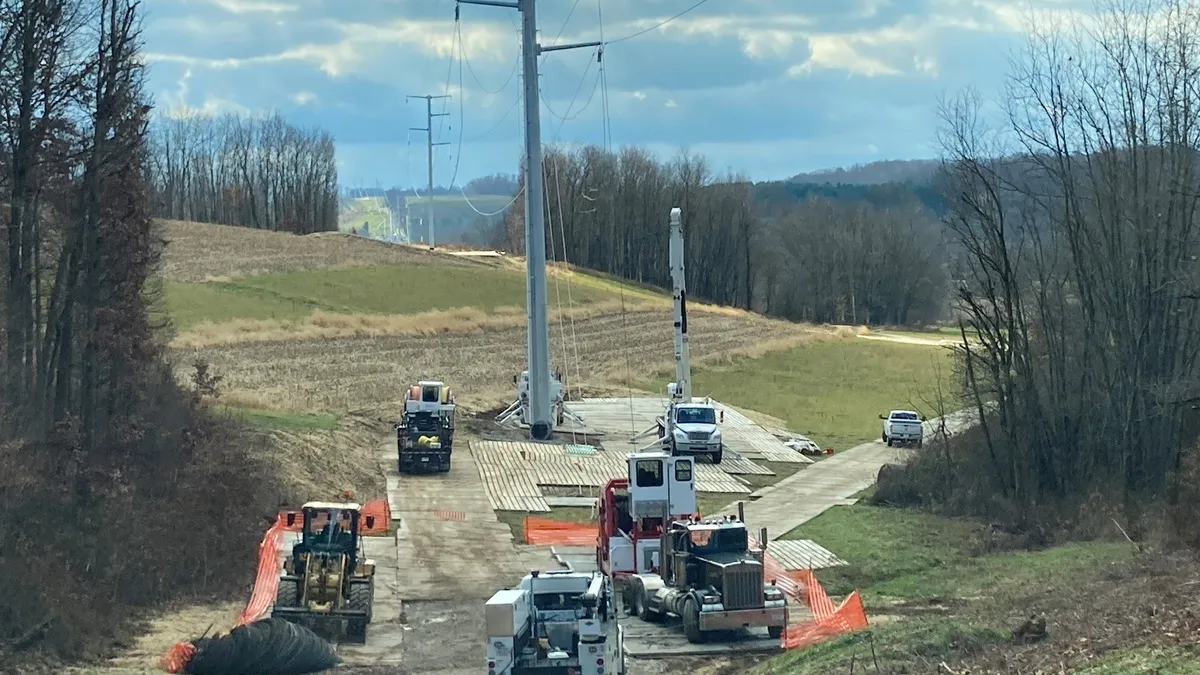Editor’s note: This story has been updated to include a response from PJM.
Dive Brief:
- Local transmission projects built in Ohio by utilities owned by American Electric Power, FirstEnergy, AES and Duke Energy lack regulatory oversight and should be reviewed by the Federal Energy Regulatory Commission, according to a complaint filed at the agency Thursday by Ohio’s ratepayer advocate.
- The utilities have added close to $6.5 billion in PJM Interconnection-approved “supplemental projects” to their local transmission plans since 2017 without any oversight of their need, prudence and cost-effectiveness, the Office of the Ohio Consumers’ Counsel, or OCC, said in the complaint.
- PJM assumes the Public Utilities Commission of Ohio reviews the projects, but it doesn’t, according to the OCC, which represents residential ratepayers. Besides reviewing the local projects, FERC should appoint an independent transmission monitor to help oversee them and should consider barring Ohio utilities from using formula transmission rates for them, the OCC said.
Dive Insight:
The complaint comes amid long-running concerns that utilities in regional transmission organizations like PJM are focusing their transmission investments on so-called supplemental projects that receive less scrutiny and are eligible for formula rates, which are approved by FERC outside a more rigorous rate case.
Supplemental projects are transmission expansions or enhancements that “address local reliability needs, such as customer service and load growth, equipment condition, operational performance and risk, and infrastructure resilience,” according to a summary of PJM’s regional transmission expansion plan process. The grid operator evaluates them to make sure they do not hurt grid reliability.
The OCC contends the projects fall into a regulatory gap.
“Ohio does not oversee the need for transmission facilities under 100 kV, and does not review the cost-effectiveness of any transmission facilities,” the OCC said. Also, the state doesn’t review rebuilds of existing transmission lines, according to the complaint.
More than three-quarters of the $8.2 billion in Ohio transmission projects from 2017 to 2022 are for supplemental projects, according to the OCC.
“There currently is no means by which FERC can assure Ohio consumers that the rates they pay for transmission service are just, reasonable and not unduly discriminatory or preferential,” the OCC said. “Neither FERC nor the states are overseeing the planning, need, prudence and cost-effectiveness of such projects. This regulatory Catch 22 leads to unjust, unreasonable, and duly discriminatory and preferential transmission rates for consumers in Ohio.”
FERC procedures for reviewing the costs of supplemental projects through Federal Power Act section 206 complaints or through rate cases are inadequate for protecting Ohio consumers, partly because construction would likely be underway by the time the reviews are finished, according to the OCC.
Ohio consumers need a pre-construction review process for supplemental projects, the office said.
Under the OCC’s proposed fix, FERC should require Ohio utilities to seek the agency’s approval for supplemental projects before construction starts.
Before seeking FERC approval for the projects, the utilities should be required to hold at least three meetings with stakeholders, publish a list of local transmission needs, publish a list of possible solutions to the needs and solicit stakeholder comments, according to the OCC.
FERC has made it clear that certain asset management activities, such as end-of-life decisions that do not expand the transmission system, are specific to individual transmission owners, Jeffrey Shields, a PJM spokesman, said in a written response.
“PJM has successfully worked with stakeholders to enhance the transparency of planning for supplemental projects,” he said.
In its pending proposed rulemaking for transmission planning, FERC is considering bolstering requirements around local transmission projects. The agency also held a technical conference a year ago on transmission cost management that included the issue of local projects.














